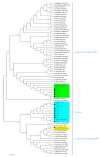Molecular and Pathogenic Characterization of Fusarium Species Associated with Corm Rot Disease in Saffron from China
- PMID: 35628770
- PMCID: PMC9147734
- DOI: 10.3390/jof8050515
Molecular and Pathogenic Characterization of Fusarium Species Associated with Corm Rot Disease in Saffron from China
Abstract
Saffron (Crocus sativus L.) is a commercial spice crop well-known throughout the world, valued for culinary, colorant, and pharmaceutical purposes. In China, Fusarium nirenbergiae was detected as causative agent of saffron corm rot, the most pervasive disease for the first time in 2020. In the present study, 261 Fusarium-like isolates were recovered from 120 rotted corms in four saffron producing fields at Zhejiang, Shanghai, and Yunnan provinces, China, in 2021. A combination of morpho-cultural features and multilocus sequence analysis (MLSA) of the concatenated rpb2 (DNA-directed RNA polymerase II largest subunit) and tef1 (translation elongation factor 1-α) partial sequences showed that the isolates from saffron belong to Fusarium nirenbergiae as well as F. commune, and F. annulatum with isolation frequencies of 58.2%, 26.8%, and 14.9%, respectively. Notably, F. commune was more prevalent than F. annulatum in the collected samples. Pathogenicity tests confirmed that both species were pathogenic on saffron corm. This is the first report of F. annulatum and F. commune causing corm rot of saffron, globally. Outcomes of the current research demonstrate that Fusarium spp. associated with saffron corm rot are more diverse than previously reported. Furthermore, some plants were infected by two or more Fusarium species. Our findings broaden knowledge about Fusarium spp. that inflict corm rot and assist the development of control measures.
Keywords: Crocus sativus; F. commune; Fusarium annulatum; MLSA; corm rot.
Conflict of interest statement
The authors declare no conflict of interest.
Figures




References
-
- Cardone L., Castronuovo D., Perniola M., Cicco N., Candido V. Saffron (Crocus sativus L.), the king of spices: An overview. Sci. Hortic. 2020;272:109560. doi: 10.1016/j.scienta.2020.109560. - DOI
-
- Pandita D. Medicinal and Aromatic Plants. Volume 14. Academic Press; Cambridge, MA, USA: 2021. Saffron (Crocus sativus L.): Phytochemistry, therapeutic significance and omics-based biology; pp. 325–396.
-
- Shokrpour M. Advances in Plant Breeding Strategies: Industrial and Food Crops. Volume 17. Springer; Berlin/Heidelberg, Germany: 2019. Saffron (Crocus sativus L.) breeding: Opportunities and challenges; pp. 675–706.
-
- Singh A.K., Chand D. Indigenous knowledge and ethnobotany associated with saffron (Crocus sativus L.) in Kashmir. Indian J. Plant Gene. Res. 2005;18:191–195.
-
- Golmohammadi F. Saffron and its farming, economic importance, export, medicinal characteristics and various uses in South Khorasan Province-East of Iran. Int. J. Farming Allied Sci. 2014;3:566–596.
Grants and funding
LinkOut - more resources
Full Text Sources
Miscellaneous

